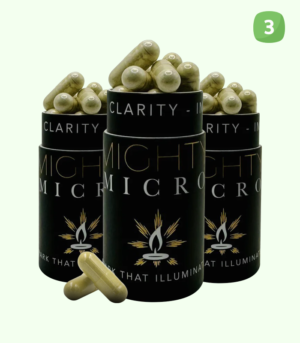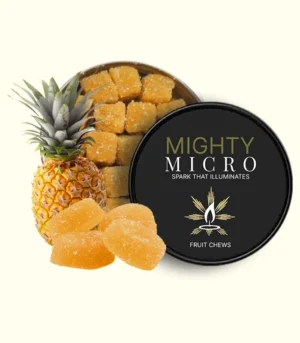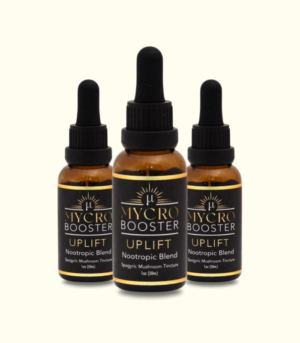As the search for effective headache relief continues, an intriguing option has emerged: microdosing psilocybin mushrooms. New findings highlighted the potential benefits of this alternative approach for alleviating chronic headaches, including migraines and cluster headaches. Microdosing involves taking tiny, sub-perceptual amounts of psilocybin, the active compound in psychedelic mushrooms, to harness its therapeutic effects without inducing a “high.”
Headaches, especially severe forms like migraines, can drastically affect daily life. While effective for some, traditional treatments often have side effects or limited results. This has driven researchers and patients alike to explore unconventional remedies like psilocybin, which is known for impacting brain activity and mood regulation.
How Do Mushrooms Work for Headache Relief?
Psilocybin mushrooms, commonly known as magic mushrooms, offer a unique mechanism of action that may help alleviate headaches, including migraines and cluster headaches. The key lies in their active compound, psilocybin, which interacts with the brain in several ways to potentially provide relief.
Serotonin Receptor Interaction
Psilocybin primarily targets serotonin receptors, especially the 5-HT2A receptor, in the brain. These receptors play a crucial role in regulating mood, pain perception, and neural signaling. By activating these receptors, psilocybin may help modulate abnormal brain activity often associated with migraines and cluster headaches.
Reducing Neural Hyperactivity
Headaches, particularly migraines, are linked to excessive neural activity and inflammation in specific brain regions. Psilocybin appears to “reset” this hyperactivity by promoting neural connectivity and reducing overactive pain pathways. This effect could lead to fewer headache episodes and less severe pain over time.
Alleviating Inflammation
Inflammation of blood vessels in the brain is a common trigger for headaches. Psilocybin may reduce vascular inflammation, which could help prevent or lessen the intensity of headache episodes. Research suggests that psilocybin’s anti-inflammatory properties might play a role in mitigating these symptoms.
Extending Periods of Remission
Cluster headaches are known for their cyclical nature, with periods of intense pain followed by remission. Studies indicate that even a single dose of psilocybin may extend remission periods for individuals suffering from cluster headaches. For some, microdosing provides consistent benefits without the need for high doses.
Supporting Mental Well-being
Stress and anxiety are major triggers for headaches. Psilocybin is known to enhance mood and reduce stress levels by promoting positive changes in brain chemistry. Microdosing may indirectly reduce headache frequency by addressing these underlying emotional triggers.
Scientific Evidence
- A 2006 study published in Neurology reported that psilocybin could terminate cluster headache cycles and extend remission periods in some patients.
- Another study in 2017 suggested that psilocybin reduced the frequency and severity of migraine attacks in participants over weeks.
- Clinical Studies:
While studies on psilocybin and migraines are limited, early research has shown promise. A study published in Neurotherapeutics (2021) found that low doses of psilocybin might reduce migraine frequency without causing significant side effects. - Anecdotal Reports:
Many individuals report relief from migraines after using psilocybin. These experiences often involve reduced pain intensity and prolonged periods without migraines.
Can psilocybin treat migraine?
Yes, psilocybin has shown promise in treating migraines by reducing frequency and severity, decreasing symptoms, and improving mental well-being, with some studies reporting significant reductions in migraine frequency and severity.
What is psilocybin?
Psilocybin is a naturally occurring psychedelic compound found in certain species of mushrooms, commonly referred to as magic mushrooms. It belongs to a class of substances known as tryptamines, which are chemically similar to serotonin, a neurotransmitter in the brain. Psilocybin is renowned for its ability to produce profound alterations in perception, mood, and cognition when ingested.
Chemical Properties
- Molecular Formula: C₁₂H₁₇N₂O₄P
- Active Metabolite: Psilocybin is converted in the body to psilocin, which is responsible for its psychoactive effects.
Traditional and Modern Use
- Traditional Use: Psilocybin mushrooms have been used for centuries by indigenous cultures for spiritual and medicinal purposes.
- Modern Research: Today, psilocybin is being studied for its potential to treat mental health conditions like depression, anxiety, PTSD, and addiction.
Buy Magic Mushroom Online
Can Psilocybin Treat Cluster Headache?
Yes, psilocybin shows potential in treating cluster headaches, according to emerging research and anecdotal evidence. Cluster headaches are a rare and debilitating neurological condition characterized by severe pain, often referred to as “suicide headaches” due to their intensity. Current treatments can be limited in effectiveness, prompting interest in alternative therapies like psilocybin.
How Psilocybin May Help?
Psilocybin, the active compound in certain psychedelic mushrooms, interacts with serotonin receptors in the brain, particularly the 5-HT2A receptor. This mechanism may help regulate the pathways involved in pain and vasodilation, which are thought to play a role in cluster headaches.
Key Research Findings
- Case Reports and Studies: Anecdotal evidence from sufferers suggests that psilocybin can abort or reduce the frequency of cluster headache attacks. A study published in Neurology (2006) found that psilocybin and LSD could prevent cluster periods or end ongoing headaches.
- Dose-Dependent Effects: Low doses, often below the level that induces hallucinations (microdosing), may be effective for some patients. Others report needing a full dose for longer-term relief.
- Remission Induction: Some users report that a single dose can lead to prolonged remission, potentially resetting the brain’s headache cycle.
What is the Best Treatment For Migraine?
The best treatment for migraines depends on whether the condition is acute or chronic, as well as individual needs. A doctor can help create a tailored treatment plan. Here’s an overview of common options:
Acute Migraine Treatment
Acute treatments aim to stop migraines as they occur. Options include:
- Nonsteroidal Anti-inflammatory Drugs (NSAIDs): Ibuprofen, naproxen, or acetaminophen for mild to moderate migraines without nausea or vomiting.
- Triptans: Sumatriptan, eletriptan, or almotriptan, often combined with naproxen, for moderate to severe migraines.
- Antiemetics: Metoclopramide or chlorpromazine to alleviate nausea and vomiting.
- Calcitonin Gene-Related Peptide (CGRP) Antagonists: Rimegepant or ubrogepant for those unresponsive to other medications.
- Dexamethasone: A steroid used to reduce the recurrence of migraines, though not for immediate pain relief.
Chronic Migraine Prevention
Preventive treatments aim to reduce the frequency of migraines and include:
- Beta-Blockers: Propranolol or metoprolol to reduce blood vessel dilation and nervous system activity.
- Antidepressants: Tricyclic antidepressants like amitriptyline, nortriptyline, or desipramine.
- Calcium Channel Blockers: Medications such as propranolol may alter calcium ion movement in blood vessels to prevent migraines.
- Anticonvulsants: Valproic acid and topiramate can significantly reduce migraine attacks.
Since migraines vary widely among individuals, it’s essential to consult a healthcare professional to determine the most effective treatment plan.
How to Prevent a Migraine?
To prevent migraines, consider adopting these lifestyle changes:
- Reduce Stress: Practice relaxation techniques like yoga or meditation, as stress can trigger or worsen migraines.
- Identify and Avoid Triggers: Keep a migraine diary to track and avoid specific triggers such as certain foods, smells, or environmental factors.
- Increase Physical Activity: Engage in regular aerobic exercise, which may help reduce migraine frequency.
- Prioritize Sleep: Maintain a consistent sleep schedule and aim for 8 hours of quality sleep each night to support overall health.
- Quit Smoking: If you smoke, quitting can help reduce migraines, as cigarette smoke is a potential trigger.
Conclusion
Microdosing psilocybin mushrooms offers a promising alternative for headache relief, particularly for migraines and cluster headaches. By targeting serotonin receptors, reducing neural hyperactivity, and alleviating inflammation, psilocybin may provide effective relief. Additionally, its benefits for mental well-being, such as stress reduction, add to its potential.
While more research is needed to confirm its long-term safety and effectiveness, microdosing could become a valuable option for headache management. Those interested should consult healthcare professionals and be aware of legal guidelines.
FAQs
What is microdosing mushrooms for headaches?
Microdosing involves taking small, sub-perceptual amounts of psilocybin mushrooms, the active ingredient in magic mushrooms, to potentially alleviate headaches without inducing hallucinations or a “high.”
How can psilocybin mushrooms help with headaches?
Psilocybin may help by interacting with serotonin receptors in the brain, reducing neural hyperactivity, and alleviating inflammation, all of which can contribute to headache relief.
Are microdosing mushrooms effective for migraines?
Some studies suggest that microdosing psilocybin can reduce the frequency and severity of migraine attacks. However, more research is needed to confirm its effectiveness for long-term migraine relief.
Can psilocybin mushrooms help with cluster headaches?
Yes, research has shown that psilocybin may help extend periods of remission in people with cluster headaches and reduce the frequency of attacks. Some users report that a single dose can terminate a cluster headache cycle.
What is the difference between microdosing and regular psilocybin doses?
Microdosing involves taking a very small dose of psilocybin (typically 1/10th to 1/20th of a typical recreational dose), which is below the threshold needed to produce psychoactive effects.
How does microdosing psilocybin mushrooms work for headache relief?
Microdosing works by modulating brain activity, reducing neural hyperactivity, and helping to regulate blood flow and inflammation, which are common triggers for migraines and cluster headaches.
Is microdosing mushrooms safe for treating headaches?
While psilocybin has shown potential for therapeutic use, safety depends on individual health conditions, the quality of the mushrooms, and the legality of psilocybin in your region. Always consult a healthcare professional before trying microdosing.
How much psilocybin should be taken for microdosing?
Microdosing typically involves taking 0.1 to 0.3 grams of dried psilocybin mushrooms, which is a fraction of the dose used for recreational use. The exact amount can vary depending on the individual’s tolerance and needs.
Can microdosing mushrooms replace traditional headache treatments?
Microdosing may complement traditional treatments for headaches, but it should not replace prescribed medications without consulting a healthcare provider. It’s important to approach alternative treatments cautiously.
Are there any side effects of microdosing psilocybin?
Microdosing is generally considered low-risk, but some people may experience mild side effects like anxiety, dizziness, or digestive discomfort. These effects are usually minimal compared to higher doses.
How often should someone microdose for headache relief?
The frequency of microdosing can vary, but many people microdose every 3-4 days, allowing time for the effects to take hold. It’s important to listen to your body and adjust the dosing schedule accordingly.
Is there any scientific research on microdosing for headaches?
Yes, several studies have shown promising results for the use of psilocybin in headache treatment, particularly for cluster headaches. Ongoing research continues to explore its full potential for migraines and other headache types.
Can microdosing mushrooms help with stress-related headaches?
Yes, microdosing psilocybin mushrooms may help reduce stress and anxiety, which are common headache triggers, potentially leading to fewer stress-induced headaches.
Where can I obtain psilocybin mushrooms for microdosing?
Psilocybin mushrooms are illegal in many countries, but in regions where they are permitted, they can be found through licensed providers or grown at home (where legal). Always check your local laws before acquiring them.
Can microdosing mushrooms be used for chronic headaches?
While some users report success in managing chronic headaches with microdosing, it is essential to consult a healthcare professional to ensure it is a suitable treatment alongside other therapies.
What should I expect when starting microdosing mushrooms for headaches?
When starting microdosing, most people do not experience strong psychoactive effects. Instead, they may notice subtle improvements in headache frequency, intensity, and overall well-being over time.
Is microdosing legal?
Psilocybin mushrooms are illegal in many countries, though some regions, like certain U.S. cities and countries such as Jamaica and the Netherlands, have decriminalized or legalized psilocybin. Always check local laws before considering microdosing.
How long does it take to feel the effects of microdosing for headaches?
The effects of microdosing can vary from person to person, but many individuals report noticing subtle improvements in headache symptoms after several days or weeks of consistent dosing.
Can I combine microdosing with my regular headache medication?
It is essential to consult with a healthcare provider before combining microdosing with any prescription or over-the-counter medications to avoid potential interactions or side effects.
What should I do if microdosing doesn’t help with headaches?
If microdosing does not provide relief, it’s important to reassess your treatment plan with a healthcare provider. There may be alternative treatments or adjustments needed for your headache management.










